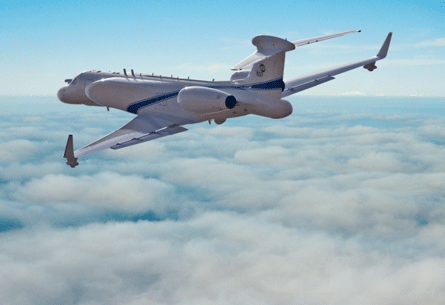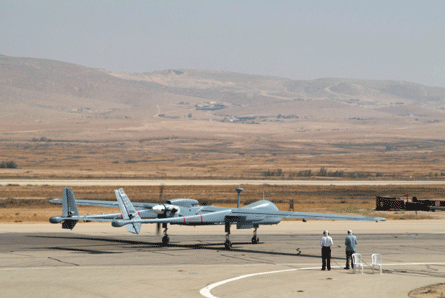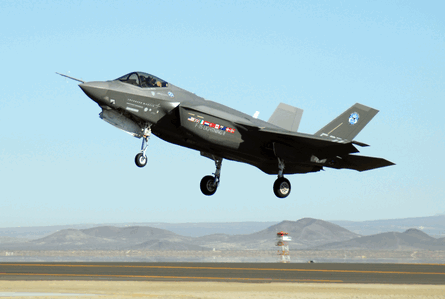Entering the fifth year of his tenure, chief executive Itzhak Nissan continues to refashion government-owned Israel Aerospace Industries with the mindset of a private company - in so far as that is possible.
The transformation of IAI precedes a decision to privatise Israel's largest aerospace company, an issue that remains deeply unpopular with the employees union and its allies in the Knesset.
But the need for change is growing more urgent. After IAI doubled revenues over the past decade to nearly $4 billion in 2009, Nissan has set a goal for the company to top that during the next 10 years, despite facing an industry-wide crisis this year that has damaged IAI's commercial and business jet earnings. By 2018, Nissan still wants IAI to top the $10 billion sales mark, a 150% improvement.
 |
|---|
© IAIUAVs like the Hunter could provide IAI's route back into combat aircraft manufacturing |
A brief list of IAI's strengths suggests Nissan's goal to reach the $10 billion sales target in nine years is not impractical.
Almost from its inception, this 57-year-old company's products have comprised a broad portfolio of aerospace and defence technology. For decades, IAI has embodied in microcosm the diversified business model now widely adopted by much larger European and US competitors.
The company has focused on specialising in seven main business areas - ranging from business jets, unmanned systems, missiles, sensors and aircraft conversions - each requiring advanced technology and management skills.
The force of necessity is also revealed in the company's more unusual business statistics. Lacking a strong domestic customer base and facing competition from companies more than 10 times its size, IAI's share of export revenues (81% of sales) and research and development spending (25% of sales) is out of all proportion to its international peers.
Broad changes may be required to make that goal a reality, to include perhaps privatisation, consolidation with domestic competitors and even swifter global expansion.
If recent trends continue, none of those priorities can be achieved through a series of bold, sweeping strokes. More likely, IAI's management will continue seeking incremental progress, and nowhere is this strategy more apparent than the heated issue of privatisation.
"There are many steps [to reach privatisation]. We are still on the first step," Nissan says. "The first step is to convince the union. Once we convince the union everything will go extremely fast. The first obstacle is to convince the union that it's good for the union, and it's good for IAI, and it's good for the employees."
Government ownership creates many challenges for a global business, not least among them the ability to make deals in the mergers and acquisitions market.
To be sure, IAI has already started dabbling in the debt markets to fund the early retirement of employees and acquisitions. Two bond issues on the Tel Aviv stock exchange since 2007 have raised hundreds of millions of dollars.
But those measures may not be enough as IAI seeks to expand to fund a broad global expansion. European companies, such as BAE Systems and Finmeccanica, have made strategic inroads in the lucrative North American market through blockbuster acquisition deals. In 2008, for example, Finmeccanica bought DRS Technologies for $5.2 billion. BAE Systems has acquired Sanders and United Defense over the past 11 years.
IAI's interest in growing in the North American market is clear. The company established Stark Aerospace in 2007 as its manufacturing base, starting with a new maritime version of the Heron 1 unmanned air vehicle. Stark is "our gate to the US market", Nissan says. "We are trying to build Stark as a holding company with many companies around it."
LIMITATIONS
But state ownership imposes limitations on the size of the deals IAI can pursue in the US market. A DRS-level acquisition does not appear to be an option until privatisation is approved.
"I think it's easy [for IAI] to acquire a company of $50 million or even $100 million," Nissan said. "But if we wanted to make a big jump the company must be privatised. We have to go public, collect money, and then we will have enough money for acquisition."
As a government-owned company, Nissan's management team faces a degree of bureaucratic oversight and intrusion that many global and even domestic competitors could not imagine.
"Our ability to invest in R&D is unfortunately affected by the government's expectation for IAI to pay large dividends," Nissan says. "For example, we signed a dividend check for more than 212 million shekels [$62.5 million] in 2008. That's 212 million shekels that could have been invested in R&D for the security of our country and to move IAI forward."
As a company that requires export licences to collect four-fifths of its revenues, IAI managers are well acquainted with navigating government bureaucracy. For IAI, adhering to export control policy is not simply a matter of following orders from the Israeli government.
Nissan cites the example of the Elta division's active electronically scanned array (AESA). The US government barred IAI from supplying its AESA radar to Saab Gripen fighter, which is competing against US-made products for contracts in India and Brazil.
"Our exports are directly affected by geopolitical considerations that often are not apparent. We need to obtain export licences from the Israeli authorities, and the factors that cause them to make their decisions may be concerns directly related to Israel's security, or indirectly such as accommodating the concerns of our allies like the USA, Russia or other countries," Nissan says.
Nonetheless, IAI's success in the foreign market remains unique compared with its global peers in the defence industry. Not only are some of its projects not supported by a domestic customer, but IAI often faces intense competition from entrenched domestic suppliers in other countries.
MONOPOLY
A case in point is IAI's Taman group, which has two divisions building electro-optical turrets and inertial navigation systems. The latter is a monopoly inside Israel. The former competes with Elbit Systems' El-Op division within Israel and with several major competitors in the global market.
In the USA alone, four major companies produce turrets in the same class as the Taman POP and MOSP.
"There's a furious competition," Igal Mevorach, Taman's director of marketing. "There are niches where we are better and there are places we cannot compete." For example, Mevorach described the US Air Force's General Atomics Predator and Reaper as "off limits" to Taman's products.
Taman is able to compete because it finds unique niches of mission need and urgent availability, which the company alone can fill. Using this strategy, Taman has managed to capture a prized contract to supply turrets for the US Army AAI RQ-7 Shadow UAV.
The pressure to compete is felt across the IAI's portfolio of products, especially where advanced technology encroaches into areas of national security. One division particularly susceptible to this trend in Elta Systems, a $1 billion division that sells advanced radars, sensors and special mission aircraft.
"We need to have something a little bit better and a little bit cheaper compared to other companies," says Baruch Reshef, deputy director for Elta's marketing and sales division.
For many years, IAI executives have quietly advocated for it to absorb its state-owned competitors Israel Military Industries and Rafael, but that has not gained traction despite even IMI's near-financial collapse four years ago.
Consolidation within Israeli industry is instead occurring in small steps, including forming new partnerships that appeared implausible not very long ago.
Indeed, IAI executives confirm that negotiations have begun with Elbit Systems, its fierce competitor in the global market for UAVs. The discussions are focused on establishing a new company to consolidate the sale of small UAVs developed by IAI and Elbit.
The Israel air force also soon plans to buy a new advanced trainer to replace its ageing Douglas A-4 Skyhawks. The emerging requirement could create another opportunity for a partnership between Elbit and IAI. The two sides are already in discussions, IAI executives confirm. The candidates for the order include the Korea Aerospace Industries/Lockheed Martin T-50 and the Alenia Aermacchi M-346, with the latter possibly marketed by Boeing.
LONG-TERM GOAL
The process of realising IAI's long-term goal to become a private company began perhaps in 2006. In that year, Nissan replaced former chief executive Moshe Keret amid a financial crisis, launching a restructuring that swept many group- and division-level managers out of the company.
The financial collapse of IMI at the same time sent a clear warning that the Israeli government would not bail out a company for management failures.
IAI has adopted more of a private company's mindset in 2006. The company formalised its make-or-buy decision process, with the goal to set up more work centres outside Israel. IAI then embarked on a new wave of global expansion, since 2007 establishing subsidiaries or joint ventures in India, Brazil and the USA.
The company also changed how it approaches research and development priorities. In certain cases, several of the company's development projects have been combined to form a single "mega project" with a budget of $300 million or more.
One example is the Gulfstream G550 conformal airborne early warning system, which made its public debut at 2009's Paris air show. The company is now discussing launching a similar product with the Airbus A320 family.
 |
|---|
© IAIThe Gulfstream G550 AEW system was a "mega project" |
There are also signs that IAI wishes to regain its status as a maker of combat aircraft. The Israeli Knesset voted to cancel the Lavi fighter programme in 1987.
The move was a strong blow against IAI, but it forced the company to commit to its then-fledgling business building long-endurance UAVs.
But the company has never fully abandoned the aircraft building business. IAI continues to build a series of business jets under the Gulfstream brand. In 2004, the company also partnered start-up Aviation Technology Group to co-develop the two-seat Javelin business jet modelled partly on the T-38 military trainer, but financial pressures forced ATG to halt work in late 2007.
Ironically, the UAV business could provide IAI's route back into the combat aircraft manufacturing market. So far, IAI has unveiled only UAVs designed primarily for intelligence, surveillance and reconnaissance missions, such as the Machatz (Heron) and Eitan (Heron 2).
If the Heron has been armed, IAI will not say. Asked about weaponising the Heron, Nir Salomon, manager of business development for IAI's Malat division, gave a cryptic response: "We can do and will do everything we know how to support our clients," he replied.
 |
|---|
© IAIThe Heron is designed primarily for intelligence, surveillance and reconnaissance |
Meanwhile, several of IAI's competitors have unveiled stealthy combat UAVs, such as the General Atomics Avenger.
If the Israeli air force operates a similar system already, it has not been publicly disclosed.
But IAI clearly stands ready to support any requirement that comes from its native air force.
Nissan identified the UAV market as one area where IAI can compete among its larger global peers. Moreover, an aircraft in the Avenger class lies within IAI's development and production capabilities.
"In the range of [4,536kg] we can do it," Nissan says. "I'm sure there is a requirement, but I cannot talk about it here."
ISRAEL SETS SIGHTS ON TWO-SEAT F35 The role of Israeli industry in the F-35 programme remains one of the last undecided pieces in Lockheed Martin's vast supply chain for the stealth fighter. While the Israeli ministry of defence negotiates pricing on 25 requested F-35s, with options to purchase 50 more, Israeli companies each want to share in the presumed industrial benefits. Israel Aerospace Industries, for example, foresees opportunities to participate in major upgrades and redesigns for the currently single-seat F-35 stealth fighter. IAI has even considered playing a role in the development of a two-seat variant. "That's possible," an IAI executive says. "There is a known demand for two seats not only from Israel but from other air forces. Advanced aircraft are usually two seats rather than single seats." All three variants of the F-35 are designed with a single seat. Programme officials have cited new advances in avionics and sensor fusion technology, which can allow a single pilot to perform missions that previously required two crew members.
The single-seat configuration also maximises commonality between the three variants. However, the programme has acknowledged plans for unspecified "follow-on development" work. A recent US Navy analysis of F-35 cost estimates briefed internally on 4 January cited "upward pressure" posed by follow-on development work, as well as ship integration costs. More immediately, Israeli industry wants a major role in the supply chain for the baseline aircraft, to include installing locally developed weapons and sensors on Israeli air force fighters. The joint programme office has reportedly agreed to integrate the Rafael Python missile on the F-35. However, radars made by IAI's Elta Systems and Israeli-made electronic warfare equipment are still in debate. Meanwhile, IAI plans to expand its aerostructures business, which already includes wings and horizontal stabilisers for F-15s and F-16s, with F-35 work, as well. It also remains unclear how F-35s purchased by the Israeli air force will be maintained. Lockheed plans to consolidate European depot maintenance work in Italy. Israeli industry, however, believes that F-35 depot maintenance should be performed within national borders. For its part, Lockheed so far is not explaining how much work it plans to offer Israel's industrial base. "Lockheed Martin is developing an industrial participation plan for Israel industry in anticipation of Israel procuring the F-35," Lockheed says. "The plan will include work opportunities for Israel industry on the F-35 programme based on the programme's best-value tenet." |
Source: Flight International




















